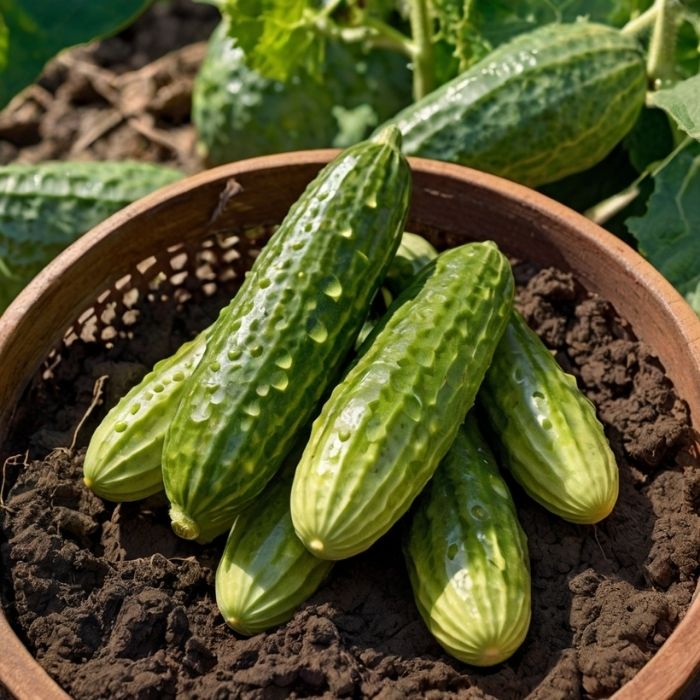Picklebush Cucumbers: The Perfect Compact Cucumber for Your Garden
If you’re a gardening enthusiast or someone who loves growing your own vegetables, you’ve likely heard of Picklebush cucumbers. These compact, bushy plants are a favorite among gardeners for their versatility, ease of growth, and delicious harvest. Whether you’re short on space or just looking for a reliable cucumber variety, Picklebush cucumbers are an excellent choice.
In this blog post, we’ll dive into everything you need to know about Picklebush cucumbers—from their unique characteristics to tips on growing, harvesting, and using them in your kitchen. Let’s get started!
What Are Picklebush Cucumbers?
Picklebush cucumbers (Cucumis sativus ‘Picklebush’) are a compact, bush-type cucumber variety specifically bred for small gardens and container growing. Unlike traditional vining cucumbers that require trellises or ample space to sprawl, Pickling cucumbers grow in a bushy form, making them ideal for raised beds, patios, or even balcony gardens.
These cucumbers are known for their small, blocky shape, typically reaching 3-4 inches in length. They have a crisp texture, mild flavor, and thin skin, making them perfect for pickling or eating fresh.
Why Choose Picklebush Cucumbers?
1. Space-Saving Growth Habit
One of the biggest advantages of Picklebush cucumbers is their compact size. They grow to about 2 feet in height and spread, making them perfect for small gardens or containers. If you’re limited on space, this variety is a game-changer.
2. High Yield in a Small Package
Don’t let their size fool you—Picklebush cucumbers are prolific producers. A single plant can yield dozens of cucumbers throughout the growing season, providing you with plenty of fresh produce for salads, snacks, or pickling.
3. Disease Resistance
Picklebush cucumbers are known for their resistance to common cucumber diseases like powdery mildew and cucumber mosaic virus. This makes them a low-maintenance option for both beginner and experienced gardeners.
4. Versatility in the Kitchen
These cucumbers are incredibly versatile. Their small size and crisp texture make them ideal for pickling, but they’re also delicious when eaten fresh, added to salads, or used as a refreshing snack.
How to Grow Picklebush Cucumbers
Growing Picklebush cucumbers is relatively straightforward, even for beginners. Here’s a step-by-step guide to help you get started:
1. Choose the Right Location
Picklebush cucumbers thrive in full sun, so choose a spot in your garden that receives at least 6-8 hours of sunlight daily. If you’re growing them in containers, place the pots in a sunny area on your patio or balcony.
2. Prepare the Soil
Cucumbers prefer well-draining, fertile soil with a pH between 6.0 and 7.0. Amend your soil with compost or organic matter to improve its texture and nutrient content. If you’re planting in containers, use a high-quality potting mix.
3. Planting Seeds or Seedlings
You can start Pickling cucumbers from seeds or seedlings. If starting from seeds, plant them about 1 inch deep and 12 inches apart. For seedlings, transplant them carefully, ensuring the root ball is well-covered with soil.
4. Watering and Mulching
Cucumbers need consistent moisture to thrive. Water your plants deeply once or twice a week, depending on the weather. Mulching around the base of the plants can help retain soil moisture and suppress weeds.
5. Fertilizing
Feed your Pickling cucumbers with a balanced fertilizer every 3-4 weeks to promote healthy growth and abundant fruit production. Avoid over-fertilizing, as this can lead to excessive foliage growth at the expense of fruit.
6. Pest and Disease Management
While Pickling cucumbers are disease-resistant, they can still attract pests like aphids or cucumber beetles. Monitor your plants regularly and use organic pest control methods, such as neem oil or insecticidal soap, if needed.
Harvesting Picklebush Cucumbers
One of the most rewarding parts of growing Picklebush cucumbers is harvesting your own fresh produce. Here’s how to do it right:
- Timing: Picklebush cucumbers are typically ready to harvest 50-60 days after planting. The cucumbers should be about 3-4 inches long and have a firm texture.
- How to Harvest: Use a pair of garden scissors or a sharp knife to cut the cucumbers from the vine. Avoid pulling or twisting, as this can damage the plant.
- Frequency: Harvest your cucumbers regularly to encourage the plant to produce more fruit. Leaving overripe cucumbers on the vine can signal the plant to stop producing.
Using Picklebush Cucumbers in the Kitchen
Picklebush cucumbers are as versatile in the kitchen as they are in the garden. Here are some delicious ways to enjoy your harvest:
1. Classic Pickles
As the name suggests, Pickling cucumbers are perfect for pickling. Try making classic dill pickles, bread-and-butter pickles, or even spicy pickles for a tangy treat.
2. Fresh Salads
Add sliced Picklebush cucumbers to your favorite salads for a refreshing crunch. They pair well with tomatoes, onions, and feta cheese.
3. Cucumber Sandwiches
For a light and refreshing snack, make cucumber sandwiches with cream cheese, fresh dill, and thinly sliced Pickling cucumbers.
4. Tzatziki Sauce
Blend grated Picklebush cucumbers with Greek yogurt, garlic, and lemon juice to make a delicious tzatziki sauce. Serve it with grilled meats or as a dip for pita bread.
5. Refreshing Cucumber Water
Infuse your water with slices of Pickling cucumbers and a sprig of mint for a hydrating and refreshing drink.
Tips for Storing Picklebush Cucumbers
To make the most of your harvest, it’s important to store Picklebush cucumbers properly:
- Refrigeration: Store fresh cucumbers in the refrigerator for up to a week. Place them in a plastic bag or wrap them in a damp paper towel to maintain moisture.
- Pickling: If you have an abundance of cucumbers, consider pickling them to extend their shelf life. Pickled cucumbers can last for several months when stored in airtight jars.
- Freezing: While cucumbers don’t freeze well fresh, you can freeze them after pickling or blending into soups or sauces.
Final Thoughts
Picklebush cucumbers are a fantastic addition to any garden, offering a compact growth habit, high yields, and delicious versatility in the kitchen. Whether you’re a seasoned gardener or just starting out, this variety is sure to impress with its ease of care and bountiful harvest.
So why not give Pickling cucumbers a try this growing season? With a little effort and care, you’ll be enjoying fresh, homegrown cucumbers in no time. Happy gardening

